What would your future-you have to say to you?
The no-pants guide to spending, saving, and thriving in the real world.
What would your future-you have to say to you?
Free Money Finance has a post up on Stacy Johnson’s 10 dumbest money moves. I thought I’d share my take.
Here are the mistakes:
1. Not having a goal
2. Not having a spending plan
3. Attempting to derive self-esteem from possessions
4. Doing what everyone else is doing
5. Starting to save large and late rather than small and soon
6. Paying interest to buy things that drop in value
7. Turning down free money
8. Buying a new car
9. Buying more house than you need or can afford.
10. Not protecting your good credit
Here is my response(and a test: Orthogonal Monkey Silicon Beam)
:
1. For most of the last 15 years, I didn’t have much for financial goals. “Get more money” isn’t specific enough to be a goal, and our spending precluded the possibility, anyway. Right now, my financial goal is simple: Get out of debt. I’m down to about $61,000.
2. We have a budget, even if it’s been partially ignored for the last couple of months. If it weren’t for my side-hustles, we would have come out negative last month.
3. We struggle with this one a lot. “Keeping up with the Joneses” is an issue in our house. My wife’s closest family is 10 years older than we are, and has more stuff, which makes it hard to visit without making comparisons. We both know it’s irrational, but it’s the way it is.
4. We are fighting this one as well. The fight is going better than #3. We’ve stopped using new debt, which shocked our friends, and I’m working on launching a new business, to break more bonds.
5. Is 30 late? We’re saving small while he fight debt, but I think we started early enough to make the rest of our lives easier.
6. We pay far too much in interest each month, but there has been absolutely no new debt since April 2009.
7. I got into my company’s retirement plan to get the match, but that ends next month. My wife’s employer killed the match 5 years ago. There’s no free money to turn down anymore.
8. We bought a new truck, as part of our debt-accumulation, in 2001. In 2005, we instead bought a car as it came off a lease. It had 11,000 miles on it and that saved us $10,000.
9. We bought our house in 1998. It sits on 1/8 of an acre. sometimes space is tight, but we’ve watched so many people trade up and find themselves in severe trouble. I’m happy we’ve stayed here.
10. This is one we’ve always guarded. No matter how much debt we’ve had, we’ve made every payment. We’re hugging the underside of an 800 FICO score. Thankfully, we’re closing in on the point where FICO no longer matters, because we’re paying in cash.
What are your biggest money mistakes?

 [Editor: This is a guest post from my good friend Terra. I’ve know her for–jeez, really–20 years. If you’re looking for a staff writer, hit her up. Seriously. She’s good people.]
[Editor: This is a guest post from my good friend Terra. I’ve know her for–jeez, really–20 years. If you’re looking for a staff writer, hit her up. Seriously. She’s good people.]
Who doesn’t want a brighter future for their child? Book store shelves overflow with parenting advice tomes and how-to guides to make “uber-kids”. Eager parents lap up promises to raise their children’s I.Q., increase their chances to get into college, and improve their social skills.
From books to apps to specialized software, there is a dizzying number of products available to help your child grow into the genius you know he or she is.
But what if I told you that the secrets to increasing your child’s likelihood to succeed in life were absolutely free. Simple things you have complete control over. No batteries or special upgrades required. No matter your income, education level, or what country you live in, these deceptively simple tips offer powerful results.
Food connects people. From the dawn of time, our species has gathered around the fire, to break bread and share our stories.
In modern times, our schedule can be crazy (between work, social activities, and, you know, life) so having dinner on the table at 6 o’clock every night is not always possible. However, studies consistently show that having a family meal at least 3 times a week has huge benefits for children (from teenagers being less likely to abuse drugs and alcohol, to increased academic success, to reduced risk of developing eating disorders or becoming obese, the implications are impressive). And it doesn’t have to be dinner, any meal will work. Consistency is the key.
Far from being boring, children find the predictable routine of family meals reassuring, promoting warm, fuzzy feelings of closeness and comfort (though teenagers will never admit it). Whether it’s take-out or made from scratch goodness, nothing says “I care about you” like sharing a meal.
Quality matters here, so remove distractions during meal time (turn off the TV, ban phones) and focus on each other. Take this time to reconnect and talk about your day and ask the kids about theirs. Make this time sacred. It matters that much.
“We need 4 hugs a day for survival. We need 8 hugs a day for maintenance. We need 12 hugs a day for growth.” – Virginia Satir, psychotherapist
Receiving a loving hug feels wonderful. But beyond feeling “nice”, hugs literally have the power to heal us and improve our lives.
Hugs have superpowers. A hug has the power to release a “happiness hormone cocktail” of oxytocin (natural antidepressant, promotes feelings of devotion, trust and bonding), dopamine (intense pleasure), and serotonin (elevates mood, negates pain and sadness) in both the giver and receiver. Bonus, hugs are naturally gluten-free, organic, and have no unpleasant side effects.
To get the most benefits, prolonged hugging is recommended, around 20 seconds. A full-body hug stimulates your nervous system while decreasing feelings of loneliness, combating fear, increasing self-esteem, defusing tension, and showing appreciation. However, this hug fest only works its magic if you’re hugging someone you trust. Since children love to be held and cuddled, this is ideal for family bonding. Not so much with that new client you just landed (awkward…).
How does hugging effect children specifically? Children who aren’t hugged have delays in walking, talking, and reading. Hugging boosts self-esteem; from the time we’re born our family’s touch shows us that we’re loved and special. All of those cuddles we give to our children are imprinted on them at a cellular level and will still be imbedded in their nervous system as adults. Hugs today equal the ability to self-love as adults. That’s an awesome gift.
We all know how important reading aloud to children is, from infants to teenagers. Reading is one of the most important factors affecting the development of a child’s brain. But reading skills are not hardwired into us; we don’t pop out of the womb quoting “Pride and Prejudice”. Reading skills need to be taught and encouraged.
Parents are a child’s first, and most important, teachers. While children can learn from flashcards and workbooks, nothing is more powerful than seeing your passion for reading. Whether you like it or not, your children are learning from your every move. What you find important, they will find important. No pressure! Teaching reading to your child requires attention, focus, and motivation. It also requires access to books, lots and lots of books.
Libraries are a great resource for developing a love of reading in your child. Most have a thoughtfully arranged children’s area offering story-time and other enrichment opportunities. However, nothing beats having a book to call your own, to hold and cherish, until the edges are worn with love.
Having a well-stocked home library, it turns out, matters. A lot. This study found that having a 500-book library was equivalent to having university-educated parents in terms of increasing the level of education their children will attain. That’s pretty powerful. It doesn’t matter if your family is rich or poor, from North America or Asia, if your parents are illiterate or college-educated, what matters is that you have books in your home.
Don’t’ have the space for 500 books? No worries. Having as few as 20 books in the home still has a significant impact on propelling a child to a higher level of education, and the more books you add, the greater the benefit.
Having a variety of books available makes a difference; especially important are reference books, with history and science texts having the greatest benefit.
No money for books? No Excuse! Dolly Parton’s Imagination Library is a great resource for free, high-quality children’s books. When you sign up, your child is mailed a new book each month until the age of five, addressed to them (a very special thing indeed).
I hope these tips empower you to take action. Small changes can have a big impact on your child’s future. Just remember, it’s not the money you make or the tutor you’ve hired or the new app you’ve installed that will catapult your baby Einstein ahead in life. It’s the quiet moments with you at home, eating, hugging, and reading that will carry them through whatever life brings their way.
Are these things you would like to focus on in your family? Do you have simple parenting tips that have made a difference in your child’s life?
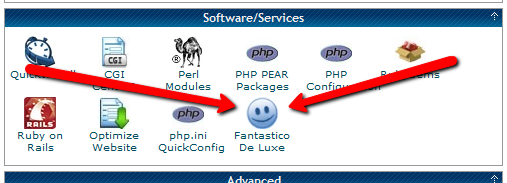
In this installment of the Make Extra Money series, I’m going to show you how to set up a WordPress site. I’m going to show you exactly what settings, plugins, and themes I use. I’m not going to get into writing posts today. That will be next time.
I use WordPress because it makes it easy to develop good-looking sites quickly. You don’t have to know html or any programming. I will be walking through the exact process using Hostgator, but most hosting plans use CPanel, so the instructions will be close. If not, just follow WordPress’s 5 minute installation guide.
Assuming you can follow along with me, log in to your hosting account and find the section of your control panel labeled “Software/Service”. Click “Fantastico De Luxe”.

On the Fantastico screen, click WordPress, then “New Installation”.
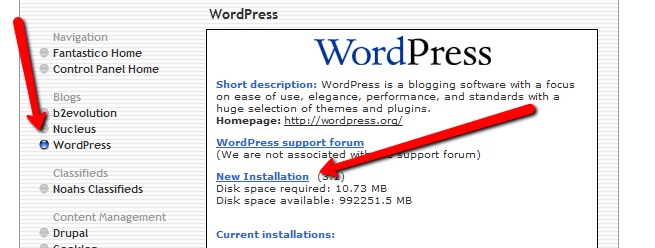
On the next screen, select your domain name, then enter all of the details: admin username, password, site name, and site description. If you’ll remember, I bought the domain http://www.masterweddingplanning.net. I chose the site name of “Master Wedding Planning” and a description of “Everything You Need to Know to Plan Your Wedding”.
Click “install”, then “finish installation”. The final screen will contain a link to the admin page, in this case, masterweddingplanning.net/wp-admin. Go there and log in.
After you log in, if there is a message at the top of the screen telling you to update, do so. Keeping your site updated is the best way to avoid getting hacked. Click “Please update now” then “Update automatically”. Don’t worry about backing up, yet. We haven’t done anything worth saving.
Next, click “Settings” on the left. Under General Settings, put the www in the WordPress and site URLs. Click save, then log back in.
Click Posts, then Categories. Under “Add New Category”, create one called “Misc” and click save.
Click Appearance. This brings you to the themes page. Click “Install Themes” and search for one you like. I normally use Headway, but before I bought that, I used SimpleX almost exclusively. Your goal is to have a simple theme that’s easy to maintain and easy to read. Bells and whistles are a distraction.
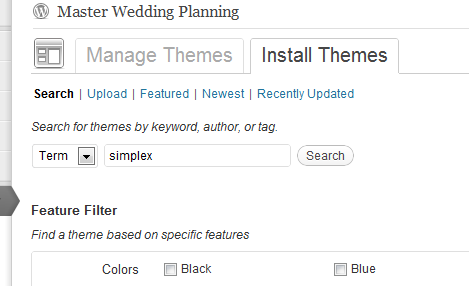
Click “Install”, “Install now”, and “Activate”. You now have a very basic WordPress site.
A plugin is an independent piece of software to make independent bits of WordPress magic happen. To install the perfect set of plugins, click Plugins on the left. Delete “Hello Dolly”, then click “Add new”.
In the search box, enter “plugin central” and click “Search plugins”. Plugin Central should be the first plugin in the list, so click “install”, then “ok”, then “activate plugin”. Congratulations, you’ve just installed your first plugin.
Now, on the left, you’ll see “Plugin Central” under Plugins. Click it. In the Easy Plugin Installation box, copy and paste the following:
All in One SEO Pack Contact Form 7 WordPress Database Backup SEO SearchTerms Tagging 2 WP Super Cache Conditional CAPTCHA for WordPress date exclusion seo WP Policies Pretty Link Lite google xml sitemaps Jetpack by WordPress.com
Click “install”.
On the left, click “Installed Plugins”. On the next screen, click the box next to “Plugins”, then select “Activate” from the dropdown and click apply.
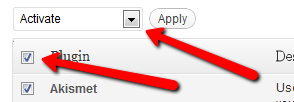
Still under Plugins, click “Akismet Configuration”. Enter your API key and hit “update options”. You probably don’t have one, so click “get your key”.
The only tool I worry about is the backup. It’s super-easy to set up. Click “Tools”, then “Backup”. 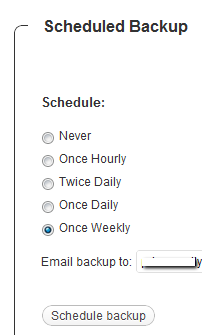
Scroll down to “Schedule Backups”, select weekly, make sure it’s set to a good email address and click “Schedule Backup”. I only save weekly because we won’t be adding daily content. Weekly is safe enough, without filling up your email inbox.
There are a lot of settings we’re going to set. This is going to make the site more usable and help the search engines find your site. We’re going to go right down the list. If you see a section that I don’t mention, it’s because the defaults are good enough.
Set the Default Post Category to “Misc”.
Visit this page and copy the entire list into “Update Service” box. This will make the site ping a few dozen services every time you publish a post. It’s a fast way to get each post indexed by Google.
Click “Save Changes”.
Uncheck everything under “Email me whenever…” and hit save. This lets people submit comments, without actually posting the comments or emailing me when they do so. Every once in a while, I go manually approve the comments, but I don’t make it a priority.
Select “Custom structure” and enter this: /%postname%/
Click save.
Set the status to “Enabled”, then fill out the site title and description. Keep the description to about 160 characters. This is what builds the blurb that shows up by the link when you site shows up in Google’s results.
Check the boxes for “Use categories for META keywords” and “Use noindex for tag archives”.
Click “Update Options”.
Check the boxes to remove each of the dates and set the alt text to “purpose” or something. This will suppress the date so your posts won’t look obsolete.
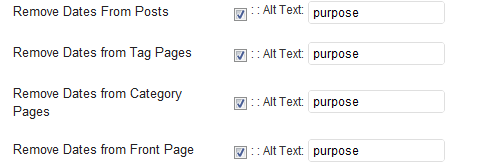
This plugin reinforces the searches that bring people to your site. It’s kind of neat. Skip the registration, accept the defaults and hit save.
Scroll to the bottom and click import. We’ll come back to this.
Select “Caching On” and hit save.
Across the top of the screen should be a giant banner telling you to connect to WordPress.com and set up Jetpack. You’ll need an account on WordPress.com, so go there and set one up. After authorizing the site, you’ll be brought back to the Jetpack configuration screen. Click “Configure” under “WordPress.com Stats”. Take the defaults and hit save.
On the contact configuration page, copy the code in the top section. You’ll need this in a moment.
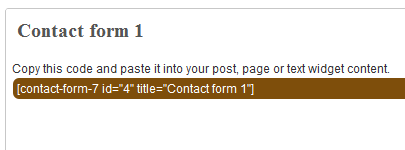
Now, we going to create a couple of static pages. On the left, click “Pages”, then “Add new”.
Name the first page “Contact” and put the contact form code in the body of the page. Hit publish.
Under Appearance, click “Menu”. Enter a menu name and hit save.
Then, under “Pages”, click the box next to “Contact”, “Disclaimer”, and any other policies you’d like to display. Hit save.
Also under Appearance, click “Widgets”. This is where you’ll select what will display in the sidebar. All you have to do is drag the boxes you want from the middle of the page to the widget bar on the right. I recommend Text, Search, Recent Posts, Popular Search Terms and Tag Cloud. In the text box, just put some placeholder text in it, like “Product will go here”. We’ll address this next time.
We’re not going to worry about getting posts in place, yet. That will be the next installment. However, the steps in the next installment could take 2 weeks to implement, and we want Google to start paying attention now. To make that happen, we need to get a little bit of content in place. This won’t be permanent content. It’s only there so Google has something to see when it comes crawling.
To get this temporary, yet legal content, I use eZineArticles. Just go search for something in your niche that doesn’t look too spammy.
Then, click “Posts”, then delete the “Hello World” post. Click “Add new”. Copy the eZine article, being sure to include the author box at the bottom, and hit publish.
To see your changes, you may have to go to Settings, then WP Cache and delete the cache so your site will refresh.
Congratulations! You now have a niche blog with content. It’s not ready to make you any money, yet, but it is ready for Google to start paying attention. In the next installment, I’ll show you how I get real unique content and set it up so Google keeps coming back to show me the love.
For the first time in 2 years(almost to the day), I am acquiring new debt that I can’t afford to pay off immediately. On a credit card.
Last Thursday, my son entered vision therapy. He has what is commonly known as a “lazy eye”, but is more properly called a “wandering eye”. His eyes don’t always lock on to whatever he is looking at. Instead, one of his eyes will (occasionally, but not always) drift to the side and shut off. His brain doesn’t interpret the signals from that eye.
We had two sessions of tests to diagnose the specific problems: $350.
We will have 28 weekly sessions of therapy @ $140 per session: $3920
There is an equipment fee: $85
That’s a total of $4355 over the next 7 months.
Insurance covers some of it, but the therapist is out-of-network, so it’s “pay first, get reimbursed later from the insurance company”. If we pay up front, we get 1 session free, bringing the price to $4215, minus insurance.
I have a health savings account that I have been trying to max out to cover this, to make my payments all pre-tax. I haven’t been able to get enough in there, yet. In fact, since I don’t have my kids on my insurance, my maximum HSA contribution is $3050.
Since finding out that vision therapy was going to be necessary, I have managed to save $1000 in cash, and about $1500 in my HSA. That’s $2500 of a $4215 bill, leaving $1715 that I still need to be able to cover.
Here is my plan:
We’re charging the entire $4215 at 11.9% interest on a card with a 2% travel rewards program. This will give me $84.30 worth of travel rewards good for reimbursing any travel expenses.
I will immediately pay off $1000 from cash savings.
I will also immediately file for an insurance reimbursement, which will cover 80% – $500, or $2972 minus a bit. Our insurance got a waiver on the pseudo-wonderful healthcare fraud act on the grounds that the plan sucks so bad that it would cost too much to comply with the law. No joke. I’m expecting about a $2500 reimbursement, and I have no idea how long that takes.
In 6 weeks, when I have maxed out my HSA contributions for the year, I will file for an HSA reimbursement for about $2500, leaving about $500 to cover some medical costs for the rest of the year. Vision therapy doesn’t count against my deductible, since my kids are on my wife’s insurance plan.
Starting in June, my debt snowball will no longer be going to max out my HSA and will instead go straight to this card, to finish paying it off as quickly as possible. That’s $750 per month.
Any money from any side work will also go towards this bill, but I don’t budget for that, because it isn’t reliable money.
The projected results:
$3215 on the credit card for 6 weeks @ 11.9% = $50 in interest payments.
After the HSA reimbursement, there will be $715 left to pay, which will be paid off in June for another $10 in interest.
When we get the insurance reimbursement, we’ll replenish the medical bill account, to start getting ready for the kid’s braces next year. We’ll drop $1500 into that account and use the remaining $1000 as a debt snowball payment.
We’ll end up paying $60 in interest to save $140 in therapy costs, so it’s good math, but I hate the idea of racking up another credit card bill. I could drop the interest costs a bit by raiding my emergency fund, but that still wouldn’t cover it all, and it would leave me with very little left for an actual emergency. I could raid the emergency fund for half of its value($700), and reduce the initial interest paid to $25 and the total interest paid to about $40, then use the $1000 leftover from the insurance reimbursement to replace my emergency fund.
Last weekend, I was in Denver for the Financial Blogger Conference. Last week, I had a sore throat that got worse each day until my tonsils started touching on Friday. I could barely talk, so I went to the doctor, then to bed.
It apparently wasn’t strep throat, but beyond that, it could be anything from motaba to weaponized syphilis*.
This is one of those occasions when I’m happy to be living in the future, where a quick trip to the clinic can knock out what would have been hopeless and fatal and few hundred years ago. Antibiotics and a day spent in bed watching super hero movies made me better. That beats bloodletting any day.
Yakezie Carnival: FINCON Edition hosted by Finance Product Reviews
Carnival of Money Pros hosted by My University Money
Carnival of Retirement #36 hosted by Making Sense of Cents
Carnival of Personal Finance #377 hosted by Money Life and More
Yakezie Carnival: Labor Day Edition hosted by Stock Trend Investing
Yakezie Carnival: The Best of Summer Edition hosted by On Target Coach
Carnival of Money Pros hosted by Simple Finance Blog
Carnival of Retirement #34 hosted by My Family Finances
Lifestyle Carnival #17 hosted by The Free Financial Advisor
Yakezie Carnival: Dog Days of Summer Edition hosted by Frugal Portland
Carnival of Money Pros: Back to School Edition hosted by See Debt Run
Nerdy Finance #7 hosted by Nerd Wallet
Yakezie Carnival hosted by The College Investor
Yakezie Carnival – Rescue Edition hosted by See Debt Run
Carnival of Financial Camaraderie #45 hosted by My University Money
Carnival of Money Pros hosted by Aaron Hung
Carnival of Retirement #32 hosted by Young Family Finance
Thanks for including my posts.
You can subscribe by RSS and get the posts in your favorite news reader. I prefer Google Reader.
You can subscribe by email and get, not only the posts delivered to your inbox, but occasional giveaways and tidbits not available elsewhere.
You can ‘Like’ LRN on Facebook. Facebook gets more use than Google. It can’t hurt to see what you want where you want.
You can follow LRN on Twitter. This comes with some nearly-instant interaction.
You can send me an email, telling me what you liked, what you didn’t like, or what you’d like to see more(or less) of. I promise to reply to any email that isn’t purely spam.
This involves giving each of the syphilis spirochetes an M16 and a Manifest Destiny indoctrination before releasing them into the wild. The transport mechanism (the “insertion method”) remains as fun as ever.
Have a great weekend!